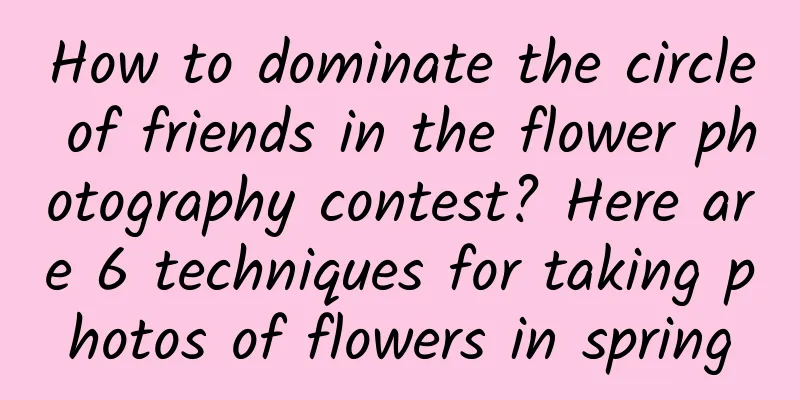How to dominate the circle of friends in the flower photography contest? Here are 6 techniques for taking photos of flowers in spring

|
Spring is here, and the annual flower photography contest in the circle of friends has quietly begun! How can you take beautiful photos of flowers? We have summarized some super useful tutorials. Please check out more tips on taking photos of flowers! We have also prepared text descriptions for some of the key points. Remember to look at the pictures first and then the text. 1 Focus <br /> Focus is often a problem when the flowers are very small. First, you need to know the minimum focusing distance of the device. If the flower is shorter than this distance from the sensor, it will definitely not be able to focus. Generally speaking, it looks better if you focus on the stamens. 📱If your phone has difficulty autofocusing, you can use your hand (or other large objects that can be on the same plane as the flower) to place it under the flower, lock the focus (long press the screen for iPhone), and then take your hand away to shoot. 📷 It is sufficient to use the camera in autofocus mode (AF). You can half-press the shutter button to lock the focus and then adjust the composition, or set the focus point manually. 2 Weather Compared to the gloomy weather, the blue sky and flowers are the best match! With sufficient sunlight, the colors of the flowers are brighter and fuller. If you want to make the sky bluer, it is best to shoot with the light facing you; if you shoot against the light, the sky will appear a little whitish due to overexposure. 3 Light Different light will make a flower show different effects, but if it is not handled well, it is easy to cause the bright parts to be overexposed and the dark parts to be underexposed. You should ensure that the subject you want to shoot is properly exposed. You can choose the morning or evening when the light is softer to better avoid the problem of abnormal exposure. Shooting flowers in the direction of the light makes them more colorful and vivid. However, the petals are easily overexposed, so you can slightly darken the picture. Flowers photographed with side light are more three-dimensional and have clearer textures, but the contrast between the dark and bright parts is too high, creating a strong sense of fragmentation. Shooting against the light makes the petals transparent and creates an atmosphere. However, it requires a higher ability to control the light and equipment. Either the flowers are likely to be completely dark, or the sky is completely white. You can switch from direct backlighting to side backlighting, or you can save it in post-production. 4 Color Correction Good-looking photos require delicate color adjustment, and proper post-production is a very important part of photography. When shooting with a camera, you can choose a model with greater tolerance and shoot in raw format to leave enough space for post-production color adjustment. You can also use post-production software appropriately when shooting with a mobile phone. 🎨 Here are some basic ideas for color grading: 1) Adjusting exposure, contrast, shadows, and highlights can compensate for overexposure and underexposure caused by sunlight. 2) Increasing saturation and contrast can make flowers more vivid. 3) Adjusting the white balance can change the overall atmosphere of the picture. 4) The color mixer can be used to adjust the brightness, saturation and hue of a certain color, such as making the sky bluer, the grass greener and the flowers redder. 5) You can use masks or local adjustment brushes to adjust only the areas that need adjustment. 6) You can also add filters and text to enhance the atmosphere. That’s all I have to say, let’s go out and have fun! Author: Heijio sister Photography: The backlit cosmos is from Tuchong Creative; the rest are taken by Heijio sister Map: Jiajia, Heijiomeimei |
<<: Interview with Shing-Tung Yau (Part 2): My work in physics and applied mathematics
Recommend
Summary of various bottlenecks encountered on the road of Android learning
[[197644]] Preface For most junior students, this...
Which tentacle of a starfish is the head? The answer is: All of them! | Nature Trumpet
Welcome to the 47th issue of the Nature Trumpet c...
What are the settings in Baidu bidding account settings?
How to enter the account settings Click to enter ...
APP promotion and operation: a complete analysis of the user growth system!
The user growth system is a mechanism that record...
Lanzhou drone mini program function, how much does it cost to develop a drone mini program?
With the continuous popularity of short videos, ma...
Competitive Product Analysis Report | Where to Go on the Weekend and Lazy Weekend, what are their respective advantages and disadvantages?
As people's income and living standards gradu...
7 Common Marketing Methods Marketers Must Know (I)
Every year there are many good marketing cases . ...
Brand Advertising Development Trends in 2022
"In the real market environment, 70% of sale...
A gamma-ray burst that occurs once in a thousand years! But does it bring more cosmic mysteries?
In a disk galaxy 2.4 billion light-years away fro...
The latest data rankings of 59 information flow platforms!
What I want to share with you today is the latest...
Help, why do you keep gaining weight? Because fat cells "remember" that you were fat...
I wonder if you have ever joined the army of weig...
[Exercise Prescription] Exercise is the best medicine! How to exercise for 9 diseases?
Doctors prescribe drugs to patients, and everyone...
Please enjoy a comprehensive Android obfuscation feast
In the daily development process of Android, obfu...
Good news for debugging database in mobile phone: Android-Debug-Database
Currently, debugging apps in the browser is becom...
How much does it cost for a Leshan merchant to customize a tableware mini program?
There is no fixed price for the customization of ...









